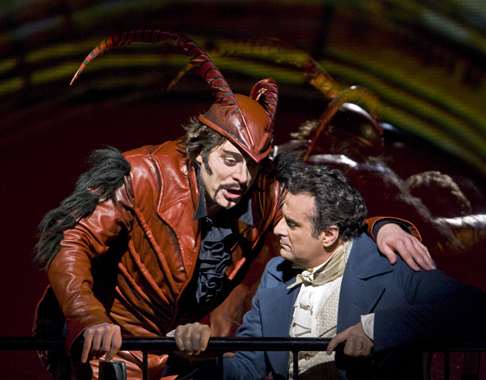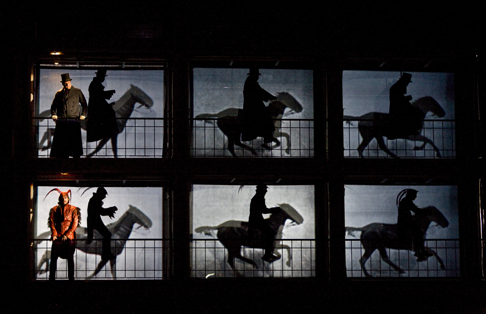17 Nov 2008
La Damnation de Faust at the MET
The Met has not staged La Damnation de Faust in a hundred years, since 1906, when it clocked a mere five performances.

The Met has not staged La Damnation de Faust in a hundred years, since 1906, when it clocked a mere five performances.
There are excellent reasons for this reluctance. Berlioz’s magical setting of scenes from Part I of Goethe’s Faust (in de Nerval’s translation, also the basis for Gounod’s opera) focuses hardly at all on the scenes of action that might be cobbled into a stage drama, but almost entirely on the poetic “background” of peasants dancing, students drinking, soldiers marching, fairies flying, devils cavorting, lords a-leaping, maids a-milking. This scene-setting and the fascinating and novel effects Berlioz drew from orchestra and chorus to depict it make up most of the evening, and traditional opera houses, even those equipped with elaborate stage machinery and full corps de ballet, seldom find it worth the effort. If you know Damnation at all, from live performance, it is probably from the concert hall, where the march and the sylphs are favorite show-off numbers, and two of its arias are greatly loved, Marguerite’s “D’amour, l’ardente flamme” and Méphistophélès’s serenade. Damnation fares a poor fourth in dramatic success as an operatic Faust, to works of Gounod, Boito and Busoni – but as a concert piece, it is rather better known than Schumann’s even less stageable Scenes from Faust. (Louis Spohr also composed a Faust, even before Goethe published his poem; one wonders what it can be like.)
As a masterpiece unwieldy by traditional means, Damnation is just the sort of opera the Met, with its spectacular stage and newly upgraded technical pizzazz ought to be putting on, rather than twisted interpretations of operas that worked just fine the old way, such as Peter Grimes, Lucia or (for that matter) Gounod’s Faust. And now the Met has done it, and done it to a turn, in a staging by Robert Lepage (of Cirque de Soleil fame, not irrelevantly), aided by “software artist” Holger Förterer.
The enormous stage is subdivided into fifteen boxes that become alleys in a library, rooms in a tavern, a moonlit bridge over a river (and the depths of that river, and Faust swimming under water), the windows of Marguerite’s house (no rural cottage for this kid, but the street-long palace of the Hohenzollerns), the stained glass windows of a church (with five naked crucifixions) and, at last, the fiery pits of Hell, filled with naked choristers. Nor are three dimensions enough for this production – red-coated demonic lizards crawl about on the surface of it, defying gravity, and soldiers march from stage bottom to top, perpendicular to the wall, before falling, wounded, three stories, into the arms of lamenting sweethearts. Marcello Giordani has to climb a ladder down from the top of the stage (four stories or so) at the evening’s beginning, when Faust is an old man, not yet satanically rejuvenated, and Susan Graham must climb up it at the end, to reach salvation. (No one ever said that route was easy.) The long musical or choral interludes between Damnation’s few action scenes are danced or acted or mimed by enormous non-singing forces (and also the Met chorus, which has seldom had so much to accomplish, while singing to boot), to so busy an extent that I found it, while thrilling, a sometimes unfortunate distraction from the luxurious musical performance Donald Palumbo’s chorus and James Levine’s orchestra were giving to Berlioz’s constantly fascinating concoctions.
While a very young crowd, accustomed to MTV style in which every note has its accompanying video image (and to never shutting their eyes and letting the music make its own image in your head), may be entranced by this production, especially when it comes to movie theaters, there may be too much of a muchness for old-fashioned movie lovers who would like to revel in sheer Berlioz. That curdled opinion only came to me two or three times, but I found little difficulty concentrating on the evening’s musical delights when they were set before me.
 John Relyea (left) as Mephistopheles and Marcello Giordani as Faust
John Relyea (left) as Mephistopheles and Marcello Giordani as Faust
These musical honors, once the dancers, acrobats, and circus and lighting technicians had all been squared away, were neatly shared. Susan Graham may not be the most sensuous of mezzos – what would “D’amour, l’ardente flamme” have been like with Troyanos’s throb in her voice? – but it was splendid to have her back in her element rather than, as her Donna Elvira demonstrated, out of it: she sings Marguerite with total assurance, and fills the hall with the aria’s yearning message. John Relyea, who is obliged to do many athletic tricks in this production (but then, he flew at his debut, in Cenerentola, and mounted and rode a horse in Rodelinda), has a sizable if gruff instrument in which Méphistophélès’s wit and slimy charm if not his malice were always evident. He can win hearts by tossing a feathery leather cap, which he does at every opportunity. The only less than excellent work came from Marcello Giordani, who has made a specialty of heroic French roles (Raoul, Cellini, Enée), but here took half the evening to steady his voice, and was obliged to slide into falsetto once or twice for Faust’s punishing tessitura.
 A scene from Part IV of Berlioz's "La Damnation de Faust" with Marcello Giordani in the title role (top) and John Relyea as Mephistopheles (bottom, in red)
A scene from Part IV of Berlioz's "La Damnation de Faust" with Marcello Giordani in the title role (top) and John Relyea as Mephistopheles (bottom, in red)
The stars, however, were James Levine and the orchestra that he has honed to diamond fineness, tricking out every brilliant detail and glow of Berlioz’s matchless ingenuity, giving us sensual pleasure to survive any distraction. The acrobats and the special effects were a treat, but I don’t think I’m the only one who found the evening’s real delight in the score itself, given such a performance.
This, surely, is as it should be.
John Yohalem